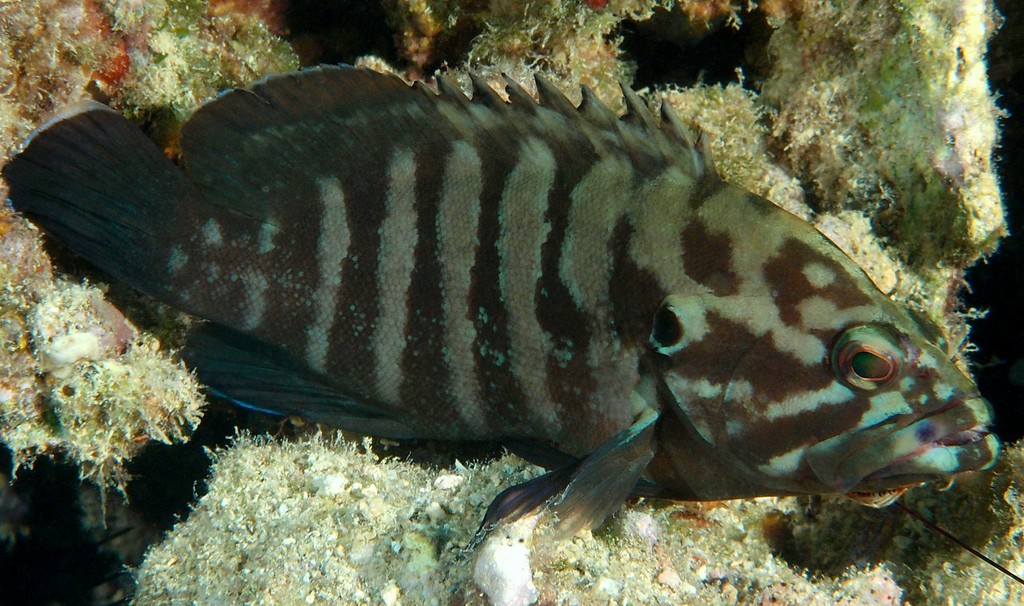CEPHALOPHOLIS BOENAK - (BLOCH, 1790)
Actinopterygii (Gigaclass) > Actinopteri (Class) > Teleostei (Subclass) > Perciformes (Order) > Percoidei (Suborder) > Epinephelidae (Family) > Cephalopholis (Genus)
Vieille chocolat, Blue-lined coral cod, Bluelined coralcod, Boenacki grouper, Brown coral cod, Brown-banded cod, Brown-banded coral cod, Brown-banded rockcod, Brown-banded grouper, Brown-banded seabass, Brown-barred grouper, Brown-barred rockcod, Charcoal grouper, Chocolate hind, Coral trout, Dusky-banded cod, Overcast grouper, Brownbarred rockcod, Briunbalk-klipkabeljou, Chokoladebars, Aosujihata, Yamihata, Garoupa chocolate, Cherna chocolate, Yamihata, ヤミハタ, 烏絲斑, 横带九棘鲈, 橫紋九刺鮨, Cá Mú sọc ngang,
Synonymes
Bodianus boenak (Bloch, 1790)
Bodianus zebra (Shaw, 1803)
Cephalopholis boenack (Bloch, 1790)
Cephalopholis boenacki (Bloch, 1790)
Cephalopholis pachycentron (Valenciennes, 1828)
Cephalopholis pachycentrum (Valenciennes, 1828)
Epinephelus boelang (Valenciennes, 1828)
Epinephelus boenack (Bloch, 1790)
Epinephelus pachycentron (Valenciennes, 1828)
Epinephelus pachycentrum (Valenciennes, 1828)
Perca fusca (Thunberg, 1793)
Serranus boelang (Valenciennes, 1828)
Serranus boenak (Bloch, 1790)
Serranus nigrofasciatus (Hombron & Jacquinot, 1853)
Serranus pachycentron (Valenciennes, 1828)
Serranus stigmapomus (Richardson, 1846)
-------------------------
Description
Dorsal spines (total): 9; Dorsal soft rays (total): 15-17; Anal spines: 3; Anal soft rays: 8; Pectoral fin rays: 15-17; Lateral line scales: 46-51; Longitudinal scale series: 86-100; Gill rakers: 7-9 + 14-17. Preopercle rounded, very finely serrate; No enlarged spines at angle, lower edge fleshy; Ctenoid scales on body including abdomen; Greatest depth of body: 2.6-3.1 in SL; Head length: 2.3-2.7 in SL (fish: 10-19 cm SL). Rounded caudal fin; Pelvic fins not usually reaching anus: 1.6-2.1 in head length. Max. length: 30.0 cm TL. Max. reported age: 11 years. Depth range: 1 - 64 m, usually: 4 - 30 m.
Vieille chocolat, Blue-lined coral cod, Bluelined coralcod, Boenacki grouper, Brown coral cod, Brown-banded cod, Brown-banded coral cod, Brown-banded rockcod, Brown-banded grouper, Brown-banded seabass, Brown-barred grouper, Brown-barred rockcod, Charcoal grouper, Chocolate hind, Coral trout, Dusky-banded cod, Overcast grouper, Brownbarred rockcod, Briunbalk-klipkabeljou, Chokoladebars, Aosujihata, Yamihata, Garoupa chocolate, Cherna chocolate, Yamihata, ヤミハタ, 烏絲斑, 横带九棘鲈, 橫紋九刺鮨, Cá Mú sọc ngang,
Synonymes
Bodianus boenak (Bloch, 1790)
Bodianus zebra (Shaw, 1803)
Cephalopholis boenack (Bloch, 1790)
Cephalopholis boenacki (Bloch, 1790)
Cephalopholis pachycentron (Valenciennes, 1828)
Cephalopholis pachycentrum (Valenciennes, 1828)
Epinephelus boelang (Valenciennes, 1828)
Epinephelus boenack (Bloch, 1790)
Epinephelus pachycentron (Valenciennes, 1828)
Epinephelus pachycentrum (Valenciennes, 1828)
Perca fusca (Thunberg, 1793)
Serranus boelang (Valenciennes, 1828)
Serranus boenak (Bloch, 1790)
Serranus nigrofasciatus (Hombron & Jacquinot, 1853)
Serranus pachycentron (Valenciennes, 1828)
Serranus stigmapomus (Richardson, 1846)
-------------------------
Description
Dorsal spines (total): 9; Dorsal soft rays (total): 15-17; Anal spines: 3; Anal soft rays: 8; Pectoral fin rays: 15-17; Lateral line scales: 46-51; Longitudinal scale series: 86-100; Gill rakers: 7-9 + 14-17. Preopercle rounded, very finely serrate; No enlarged spines at angle, lower edge fleshy; Ctenoid scales on body including abdomen; Greatest depth of body: 2.6-3.1 in SL; Head length: 2.3-2.7 in SL (fish: 10-19 cm SL). Rounded caudal fin; Pelvic fins not usually reaching anus: 1.6-2.1 in head length. Max. length: 30.0 cm TL. Max. reported age: 11 years. Depth range: 1 - 64 m, usually: 4 - 30 m.
Color
Juveniles (<4 cm SL) without bars, rear half of body greenish yellow.
Head and body brown, with 7-8 darker bars on body; Some fish with brown bands radiating from eyes and pale median band from chin to nape; Large black spot between upper and middle opercular spines; Median fins darker distally, with pale bluish line on outer edges (except central part of caudal fin).
Etymology
Cephalopholis: from Greek, kephale = head + from Greek, pholis = scale. Referring to completely scaled head of Cephalopholis argus.
boenak: from Ikan Boenak (Ikan=fish), Indonesian name for this species (although Bloch believed it was from Japan).
Original description: Bodianus boenak Bloch, 1790 - Type locality: Japan (erroneous, is Indonesia).
Distribution
Indo-West Pacific: East Africa (Kenya, Tanzania, Mozambique), Persian Gulf, Aldabra (Seychelles), Comoros, Madagascar and western Mascarenes (La Réunion, Mauritius), east to Philippines, New Ireland (Papua New Guinea) and Solomon Islands, north to Shanghai (China) and Ryukyu Islands (Japan), south to Western Australia, Queensland (Australia) and New Caledonia.
Juveniles (<4 cm SL) without bars, rear half of body greenish yellow.
Head and body brown, with 7-8 darker bars on body; Some fish with brown bands radiating from eyes and pale median band from chin to nape; Large black spot between upper and middle opercular spines; Median fins darker distally, with pale bluish line on outer edges (except central part of caudal fin).
Etymology
Cephalopholis: from Greek, kephale = head + from Greek, pholis = scale. Referring to completely scaled head of Cephalopholis argus.
boenak: from Ikan Boenak (Ikan=fish), Indonesian name for this species (although Bloch believed it was from Japan).
Original description: Bodianus boenak Bloch, 1790 - Type locality: Japan (erroneous, is Indonesia).
Distribution
Indo-West Pacific: East Africa (Kenya, Tanzania, Mozambique), Persian Gulf, Aldabra (Seychelles), Comoros, Madagascar and western Mascarenes (La Réunion, Mauritius), east to Philippines, New Ireland (Papua New Guinea) and Solomon Islands, north to Shanghai (China) and Ryukyu Islands (Japan), south to Western Australia, Queensland (Australia) and New Caledonia.
Biology
Mainly a coastal species. Inhabits silty dead reefs in protected waters. May also be seen on live coral. Secretive. Feeds mainly on fish and crustaceans. Courtship and pair spawning were observed by Donaldson (1989). Diandric protogynous hermaphrodite. Heavily fished in some areas in Southeast Asia, and taken in handline fisheries in Australia. Juveniles are also collected for the aquarium industry.
Last update: 3, September 2024
Mainly a coastal species. Inhabits silty dead reefs in protected waters. May also be seen on live coral. Secretive. Feeds mainly on fish and crustaceans. Courtship and pair spawning were observed by Donaldson (1989). Diandric protogynous hermaphrodite. Heavily fished in some areas in Southeast Asia, and taken in handline fisheries in Australia. Juveniles are also collected for the aquarium industry.
Last update: 3, September 2024
